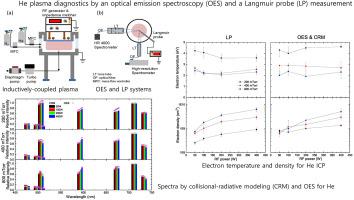Spectrochimica Acta Part B: Atomic Spectroscopy ( IF 3.2 ) Pub Date : 2021-07-31 , DOI: 10.1016/j.sab.2021.106269 Kil-Byoung Chai 1 , Duck-Hee Kwon 1

|
An optical emission spectroscopy (OES) technique combined with a collisional-radiative (CR) model is developed for measuring the electron temperature and density of low temperature helium (He) plasma. The CR modeling self-consistently solves the steady state population balance equation, including nonlinear radiation trapping and heavy particle collisional ionization as well as linear electron-impact processes and metastable diffusion. The CR modeling considers both Maxwellian and non-Maxwellian electron energy distributions, and the gas temperature parameter needed in the CR modeling is measured by adding a small amount of nitrogen gas and analyzing the rotational spectra of N species. The electron temperature and density determined by the CR modeling and OES in He inductively-coupled plasma are compared with the values measured by a Langmuir probe for the RF power and the gas pressure variations. The considered plasmas are in the ranges of electron temperature 2–5 eV and density 108–1010 cm−3, and the gas pressure 200–800 mTorr and temperature 500 K. The trend and absolute values by the two methods are in overall agreement within the uncertainty range for the various RF powers and the gas pressures. The underlying population kinetics for the OES spectra is analyzed in detail.
中文翻译:

非平衡低温氦等离子体的光发射光谱和碰撞辐射建模
开发了一种结合碰撞辐射 (CR) 模型的光学发射光谱 (OES) 技术,用于测量低温氦 (He) 等离子体的电子温度和密度。CR 建模自洽求解稳态粒子群平衡方程,包括非线性辐射俘获和重粒子碰撞电离以及线性电子碰撞过程和亚稳态扩散。CR建模同时考虑Maxwellian和非Maxwellian电子能量分布,CR建模所需的气体温度参数通过加入少量氮气并分析N的旋转谱来测量物种。将 CR 模型和 He 电感耦合等离子体中的 OES 确定的电子温度和密度与 Langmuir 探针测量的射频功率和气压变化值进行比较。所考虑的等离子体在电子温度2-5 eV和密度10 8 -10 10 cm -3,气体压力200-800 mTorr和温度500 K的范围内。两种方法的趋势和绝对值在总体上各种射频功率和气压的不确定性范围内的一致性。详细分析了 OES 光谱的基本种群动力学。









































 京公网安备 11010802027423号
京公网安备 11010802027423号